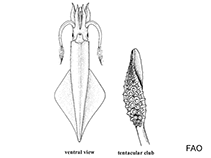Loliolus uyii (Wakiya & Ishikawa, 1921)
Little squid
Upload your photos
Google image | No image available for this species;
drawing shows typical species in Loliginidae.
Google image | No image available for this species;
drawing shows typical species in Loliginidae.
Classification / Names Common names | Synonyms | CoL | ITIS | WoRMS
Cephalopoda | Myopsida | Loliginidae
Environment: milieu / climate zone / depth range / distribution range Ecology
Pelagic-neritic; non-migratory (Ref. 75927); depth range 50 - 150 m (Ref. 275), usually ? - 150 m (Ref. 75927). Tropical; 35°N - 6°N, 76°E - 136°E
Distribution Countries | FAO areas | Ecosystems | Occurrences | Introductions
Indo-West Pacific.
Length at first maturity / Size / Weight / Age
Maturity: Lm ? range ? - ? cm Max length : 10.0 cm ML male/unsexed; (Ref. 275)
Short description Morphology
Mantle cylindrical, short, its width about 25% of the mantle length. Fins rhomboidal, length about 60% of mantle length. Tentacular clubs expanded, suckers 56-60, quadriserial, 8 proximal suckers greatly enlarged with smooth rings, teeth absent; medial and distal rings with 7 to 10 very low, broad, plate-like or semilunar teeth. Arm suckers biserial; sucker rings on arm III with 3 to 6 truncate teeth. Left ventral arm hectocotylized along distal 2/3 with about 75 suckerless papillae. (Refs. 275, 128027).
Life cycle and mating behavior Maturity | Reproduction | Spawning | Eggs | Fecundity | Larvae
Members of the class Cephalopoda are gonochoric. Male and female adults usually die shortly after spawning and brooding, respectively. Mating behavior: Males perform various displays to attract potential females for copulation. During copulation, male grasp the female and inserts the hectocotylus into the female's mantle cavity where fertilization usually occurs. Life cycle: Embryos hatch into planktonic stage and live for some time before they grow larger and take up a benthic existence as adults.
Main reference
References | Coordinator | Collaborators
Roper, C.F.E., M.J. Sweeney and C.E. Nauen. 1984. (Ref. 275)
IUCN Red List Status (Ref. 130435)
Data deficient (DD) ; Date assessed: 01 July 2015
CITES status (Ref. 108899)
Not Evaluated
CMS (Ref. 116361)
Not Evaluated
Threat to humans
Human uses
| FishSource |
Tools
More information
Internet sources
BHL | BOLD Systems | CISTI | DiscoverLife | FAO(Publication : search) | Fishipedia | GenBank (genome, nucleotide) | GloBI | Gomexsi | Google Books | Google Scholar | Google | PubMed | Tree of Life | Wikipedia (Go, Search) | Zoological Record



